Great Hammerhead Shark Profile
While the most famous shark in the world is undoubtedly the great white, there’s another large predatory shark that’s probably more recognisable.
The clue is in the name, but unlike that blunt object, the hammer in this shark’s toolbox is a highly sophisticated piece of kit.
There are at least nine species of hammerhead shark, and of them all, the great hammerhead is the largest, reaching up to 6 m (20 ft) in length.
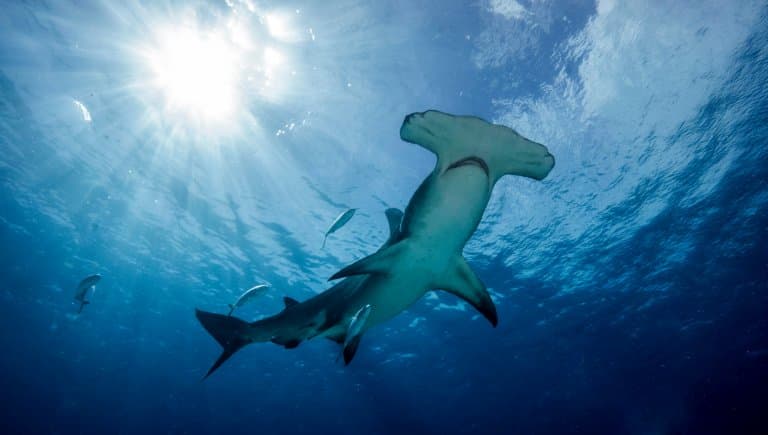
Great Hammerhead Shark Facts Overview
| Habitat: | Tropical waters, coral reefs and open water |
| Location: | All large, warm oceans and seas |
| Lifespan: | Possibly up 30 years |
| Size: | 3.5 – 6.1 m (11.5 – 20 ft) |
| Weight: | 500 lb (230 kg) |
| Color: | Light Gray to olive above, white bellied |
| Diet: | Crustaceans, cephalopods, sharks, bony fish, stingrays |
| Predators: | Larger sharks |
| Top Speed: | Unknown |
| No. of Species: | 1 |
| Conservation Status: | Critically endangered |
The great hammerhead is found in tropical and temperate coastal waters of the Atlantic, Gulf of Mexico, Caribbean and Mediterranean, Pacific and Indian ocean.
This shark has an extraordinarily specialised set of organs on its face and a sleek and surprising body morphology behind it that works in tandem.
They favour inhabiting coral reefs, where they are a solitary and nomadic predator. They have few enemies other than orca, and patrol the sea bed hunting out hidden fishy treasures.
They hunt at dawn and dusk and will feed on a variety of prey, including crustaceans, cephalopods, stingrays, skates, bony fish and even other sharks, such as the grey reef shark.
Sadly, they’re now critically endangered due to overfishing, and as one of the more elusive species of shark, they offer few obvious solutions to their decline.
Interesting Great hammerhead Shark Facts
1. Their weird faces are sensor arrays
The characteristic flat and laterally-expanded face of the hammerhead is there for a good reason.
Aside from the obvious advantage of having a 360° field of view, the head, known as a cephalofoil, provides plenty of surface area for the shark’s other senses, too.
It’s thought that there’s a larger olfactory surface available with a head this flat, which gives the shark a heightened sense of smell as well as a wide visual field, but what may be the most useful element is the vast network of electrosensory cells present.
Across the underside of the hammerhead’s paddle face is a field of little pores, each filled with a special gel that contains molecules sensitive to electrical fields.
These are known as the ampullae of Lorenzini and they’re responsible for picking up on changes in voltage in the water. They’re so sensitive that it’s thought some sharks can navigate by the Earth’s magnetic fields during long-distance migrations.
In the hammerhead, they’re also great for picking out the tiny heartbeats of skates and rays trying to hide under the sand. 1
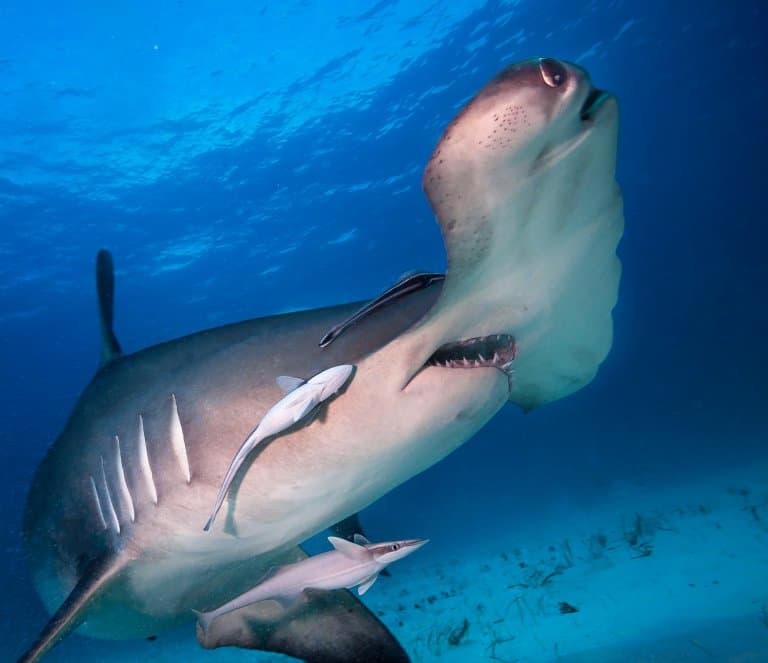
2. They use their head to pin prey to the floor
A great hammerhead has been witnessed on multiple occassions using its cephalofoil to knock stringrays to the sea bed with a blow, before using its head to pin the creature to the floor and pivoting to take a bite.
These observations suggest that great hammerheads utilise their unique heads to disable rays.
3. Cephalofoil means “head wing”
And there is a hypothesis that hammerheads gain some level of lift from the wing-shaped head.
Hammerheads are naturally dense animals, and since sharks lack the swim bladder of their bony neighbours, they have to come up with other ways to prevent sinking.
The pectoral fins are naturally wing-like and help keep the shark up in the water as long as it keeps moving, and it appears that the head, though not responsible for lift at a neutral angle, might aid in manoeuvrability, either by acting as a forward rudder or aiding with lift at certain angles.
2
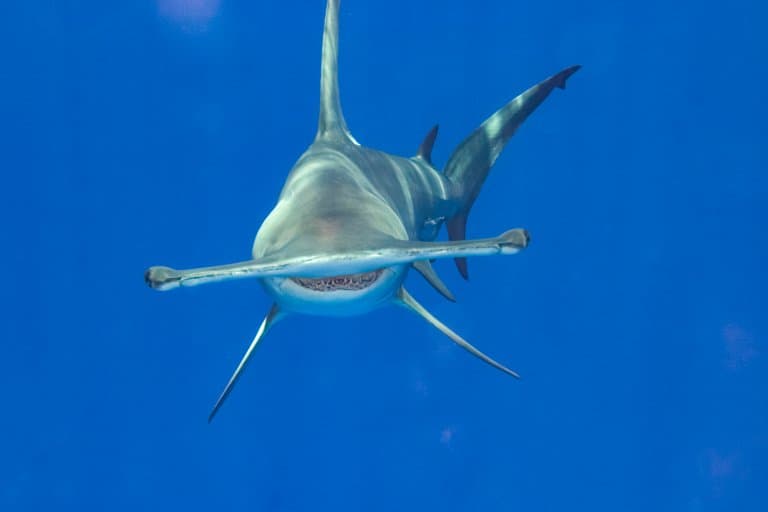
4. They can “roll swim”
So, these sharks have some weird arrangements when it comes to tails and rudders and wings. And this allows them to do some strange things in the water.
It was recently discovered that hammerheads swim on their sides, at angles between 50° and 75°, and they spend a lot of time in these orientations.
Since the head is kind of cumbersome, and the dorsal fin is so long, they’ve figured out that it’s more energy efficient to roll over, using the dorsal fin and tail as wings for lift, to travel over longer distances when not foraging.
In fact, great hammerheads may spend 90% of their time swimming this way. So, when hunting, they’re belly-down, scanning the sand with slow agility, and when moving from one place to another, they pack up their equipment and make use of a peculiar, low energy body orientation to save energy. 3
5. They give birth to live young
Like many sharks, great hammerheads give birth to live young. Despite being the largest of the hammerheads, there’s still very little information on what goes on both before and after this in relation to breeding.
Shark breeding is notoriously difficult to study and this of course becomes more of an issue as a species’ population drops to the critically endangered level that these hammerheads currently sit.
It’s thought that an adult female can produce upwards of 40 pups in a litter, after a gestation of around 11 months. Mating seems to occur in the shallows, and the females give birth once every two years.
There is recent evidence that they have secret shark nurseries, in which they give birth; spaces of relative protection and seclusion, where the pups can feed and grow in shallow, warm water, without the threat of a bull or tiger shark coming by to gobble them up. 4
6. They’re top predators
The term apex predator is thrown around too often, and should really only refer to those animals who truly have no equals. In the ocean, there is one true apex predator: the killer whale.
That said, there are some close runners-up, and the great hammerhead sits high up the rankings.
The trophic cascade is separated into five levels, with apex predators at number 5. These hammerheads sit around 4.3, making them significant predators with few enemies.
The great hammerhead is a large shark by all accounts, and though adults may occasionally be predated upon by great white sharks and orcas, most of their natural threats come when they’re young and small. However, there’s a much more serious threat from outside the ocean.
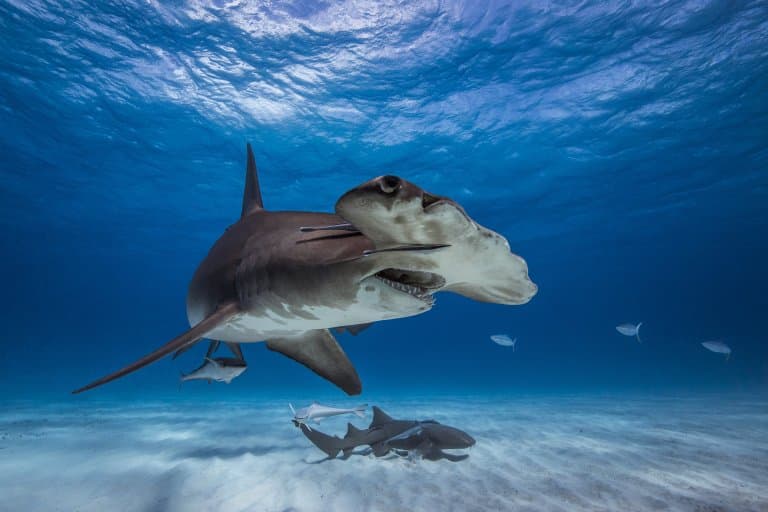
7. Great hammerhead will occassionally engage in cannibalism
The great hammerhead shark in particular is known as being the most aggressive and when food is scare, they will eat other hammerhead sharks, and even its own young to survive.
8. They once preyed on the megalodon
The megalodon is an extinct species of shark, that is thought to be the largest shark that ever lived, growing up to 20 m (67 ft) in length.
Researchers found fossil teeth belonging to great hammerheads in the Gatun Formation of Panama, that suggest they once preyed upon juvenile megladon in an ancient nursery 10 million years ago. 5
9. They have a perhaps undeserved reputation
While great hammerheads are lethal predators and could be seriously dangerous to a human in the water, there has only been 34 recorded bites without a single human death recorded by the International Shark Attack File.
Divers have reported that great hammerheads are often shy, and will approach divers tentatively or are non-reactive. In fact, there’s many rules around swimming with hammerhead sharks just to help them feel comfortable and not flee. This includes not exhaling bubbles when they’re nearby.
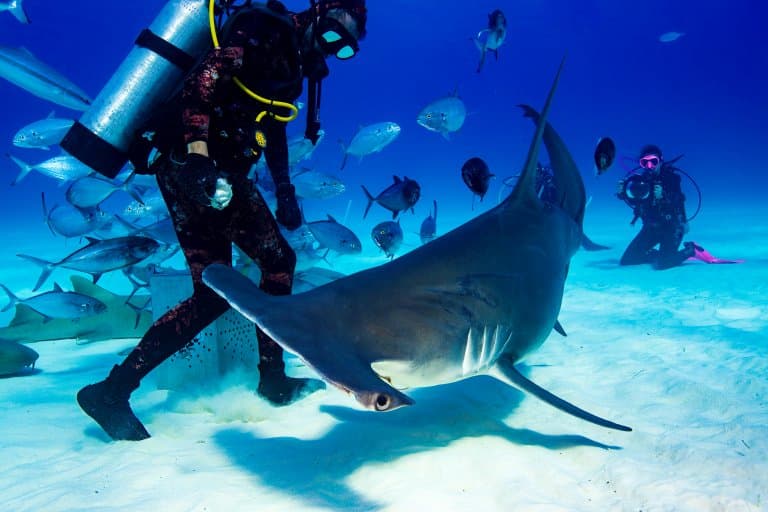
10. There are many threats to hammerheads
The shark fin trade is responsible for the decimation of shark populations all over the Southern hemisphere and beyond. But they’re not alone in targeting sharks.
Commercial fishing of various kinds brings up sharks either on purpose or as by-catch while fishing for other animals, and some are even culled as part of beachgoer protection efforts, despite hammerheads having never been responsible for human death.
Tragically, as the numbers of these sharks dwindle, researchers still don’t have enough pieces of critical information to know best how to protect them.
One thing is for certain, the fishing industry is responsible for the vast majority of the destruction of ocean populations. Fishing nets alone make up a substantial portion of waste plastic in the oceans, floating about for potentially hundreds of years, and snagging untold numbers of animals in the process.
Climate change is another problem, with rising water temperatures contributing to shifts in population dynamics, making the species more vulnerable but also much more complicated and difficult to understand from a research perspective. 6
Great Hammerhead Shark Fact-File Summary
Scientific Classification
| Kingdom: | Animalia |
| Phylum: | Chordata |
| Class: | Chondrichthyes |
| Order: | Carcharhiniformes |
| Family: | Sphyrnidae |
| Genus: | Sphyrna |
| Species Name: | Sphyrna Mokarran |
Fact Sources & References
- Alex Fox (2021), “New Evidence Suggests Sharks Use Earth’s Magnetic Field to Navigate“, Smithsonian Magazine.
- Gaylord, M.K., Blades, E.L. & Parsons (2020), “G.R. A hydrodynamics assessment of the hammerhead shark cephalofoil“, Scientific Reports.
- Nicholas L. Payne et al. (2016), “Great hammerhead sharks swim on their side to reduce transport costs“, Nat Commun.
- Lindsay French, Jennifer Dorrian and Gavin Naylor (2018), “Great Hammerhead“, Florida Museum of Natural History.
- Catalina Pimiento et al. (2010), “Ancient Nursery Area for the Extinct Giant Shark Megalodon from the Miocene of Panama“, PLoS One.
- Miller, Margaret H, Carlson, J, Hogan, L. (2014), “Status review report : great hammerhead shark (Sphyrna mokarran)“, United States, National Marine Fisheries Service.
